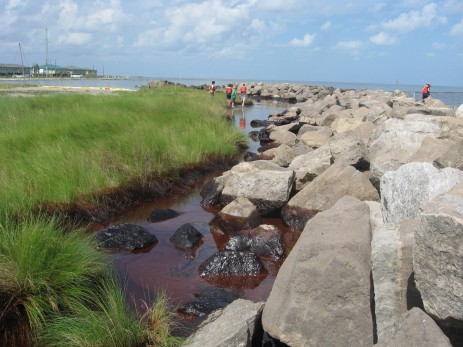 An oily mess on the Gulf coast.Photo: David HelvargBy the end of the summer, it could be raining oil along the Gulf of Mexico.
An oily mess on the Gulf coast.Photo: David HelvargBy the end of the summer, it could be raining oil along the Gulf of Mexico.
Hurricane Alex is the first of a series of 14 named storms predicted for the 2010 hurricane season. The Gulf is warmer than it’s been since before 2005 when unusually warm water super-charged Hurricanes Katrina and Rita and also led to massive coral bleaching and die-offs across the Caribbean. Even as it makes landfall 600 miles from the main oil slicks, the waves and winds generated by Alex have forced skimming operations to be cancelled and threatened to push oil farther onto the shores and into the marshes that include 40 percent of America’s coastal wetlands.
During this potentially devastating storm season of 2010, the Gulf’s massive fields of oil could be swept ashore, mixed in the water column, or even lifted into the storm clouds to rain out in oily downpours, like some Biblical plague, on the coastal communities of the oil-producing Gulf.
In 2005, just after Hurricane Katrina, I remember stopping in Biloxi, Miss., by an 8,000-ton, 600-foot-long casino barge that the 25-to-30-foot storm surge had driven half a mile across Beach Drive. Somewhere underneath its barnacle-encrusted black hull was a historic mansion. Another casino barge had gouged a hole halfway up the stately six-story yellow brick yacht club before coming to rest next to it. The beach was covered for miles in plastic buckets, insulation, mattresses, furniture, chunks of drywall, and Styrofoam pellets that the seabirds were eyeing as potential snack food. I felt like an eco-geek being more concerned about the gulls and wetlands than the lost revenue from the casinos that everyone else seemed to be obsessing about.
On June 28, 2010, tar balls started coming ashore on Biloxi’s cleaned-up white sand beaches just as they had been on the squeaky sugar-white sands of the Florida Panhandle for days and weeks. Far less dramatic than what I’d seen after Katrina, these are the first signs of what promises to be a far more persistent and continuous fouling of beaches for months and possibly years to come. With 95 percent of the oil still offshore, these first small tar balls represent a dire threat to the economic drivers of the Gulf states that are its coastlines, particularly for the state of Florida, where they could be scraping oil off the sand till there’s no sand left.
Even after the most visible oil is cleaned up by a living wave of work crews and skimmers, much of it remains behind, infiltrating into the backwater wetlands or the sand itself.
In Grand Isle, La., Greenpeace marine biologist (and Ocean Campaign Director) John Hocevar takes me out on Greenpeace’s 27-foot diesel jet-powered rigid hull inflatable, the Billy Greene, named for a filmmaker who loved the natural world but was cut down by an urban predator. We zip across to Grand Terre Island, which had been hit by oil two days earlier. The water on the crossing is full of pods of dolphin workboats and oily rainbow sheens. Just as New Orleans after Katrina looked like a Woodstock for first responders, the waters around Grand Isle now look like a boat show for oil-spill response vessels.
The beach on Grand Terre is boomed off and relatively cleaned off, though there’s still some heavy oil left between a rock jetty and the marsh behind it. I stumble and climb on the side of the boulder-pile break wall to where the oil is thick and brown on the rocks and along the marsh grass. The tidal swell between the rocks slowly lifts and lowers the thick sludgy oil, reminding me of a brown diseased lung rising and falling in an open chest. It seems like a living thing and keeps me mesmerized for some minutes till I get a call from a CNN producer asking if I think the Coast Guard has the resources to meet this latest disaster. The media presence is heavy as the humidity on these bayous and hopefully won’t go away once the exploding oil bore is sealed.
On our way off the beach, there are two dolphins swimming by some yellow blackened oily boom. “Some oil became pebble-like interacting with the sand,” Hocevar tells me. More oil appears as red spots on the surface of the sand, though he says it has also sunk below the surface. I take a stick to dig with and see more copper-like spots appear along the edges of the hole I’ve created. After confirming what he’s said, I throw the sandy stick away and brush my hands against each other, only the sand won’t come off. I try again. When I rub my hands on my jeans, they leave an oily brown stain on the denim and thin brown streaks of oil on my palms. Now multiply that one million times or more and add wind fetch and storm surges.
I seriously doubt that we can “make it better than it was before,” as President Obama promised he would do for the Gulf region in his recent White House speech on the disaster. BP also makes promises in radio ads that play every day around here: “We may not always be perfect but we will make it right.” I love the calculated tone of the ad. Hell, we all know nobody is perfect. I may have killed my grandma and shot my dog, but I’ll make it right.
Meanwhile, we continue to hope for more luck than we’re likely to get during this hurricane season.


